With
all the rumblings about 'Disclosure' going on all around, I can't help
but wonder why those who are interested in this topic seem to be missing
the biggest cover-up of all: cometary/asteroid disruptors/destroyers of
history.
Destroying history means, of course, destroying large segments of the
human population who pass history on to their offspring. When you find a
blank spot in history, a discontinuity, you can pretty well figure out
that something really awful must have happened.
I've recently been wading through the complete works of Anatoly Fomenko. Those of you who have read my book The Secret History of the World
know that I referred to him and his theories, but this was based on the
available articles about it in English at the time. I've now been
gifted with volumes 1 through 4 of his 7 volume work, along with the
images from the final three volumes which are still being translated.
It's a real revelation.
Now, for those of you who are familiar with this work, let me
assure you that I am not reading uncritically. What I do find is that
Fomenko's deconstruction is masterful. His method and results that
prove that our history has been falsified are, in my opinion,
incontrovertible. The numbers simply do not lie. What I am not very
impressed by are some of his interpretations of what he does accept as
data and his reconstruction is not satisfactory at all. He seems to be
entirely unaware of why history must have needed to be re-written: repeated cometary destruction of Europe and the Mediterranean regions over the past 2000 years or more. That general ignorance is widespread and it has a powerful bearing on the 'Disclosure' issue, I think.
Some of the recent 'Disclosure' trends seem to include information from
'government insiders' who have told their stories, or whispered hints of
amazing technology just waiting for all of us when this 'inevitable'
event happens. Sorry, but I think its all wishful thinking. Why?
Because what is interesting to me is the fact that, with all the
tracking of government documents and conspiracies and so on, it seems
that no one has mentioned to the purveyors of 'Disclosure' just how
interested the government actually is in cometary impacts.
On 4 November 1996, Edward Teller wrote to then British Prime Minister, John Major:
Every few human lifetimes, there is a bombardment event like that
which occurred in Siberia in 1908, wiping out most life over an area of
about 10,000 square miles... Quantitatively, the time-averaged
loss-of-life is comparable to that due to large floods, earthquakes and
aeroplane crashes... The advent during the last half-century of
reasonably large-scale rocket propulsion has given us the technological
means necessary to avert such impacts.
Teller, apparently, believed that the greatest threat to humankind is not nuclear war, but asteroid or comet impact.
Some groups within the military believe the problem to be very serious
indeed. A document on the subject of impact threat - now cleared for
public release but formerly classified - was prepared by the U.S.
Department of Defense in 1996. (Planetary Defense: Catastrophic Health Insurance for Planet Earth, 1996)
Due to a lack of awareness and emphasis, the world is not socially,
economically, or politically prepared to deal with the vulnerability of
impacts and their potential consequences. Further, in terms of existing
capabilities, there is currently a lack of adequate means of detection,
command, control, communications, computers, and intelligence (C41),
and mitigation...
In terms of courses of action in the event of a likely impact of an
ECO, [earth crossing object], other than a nuclear option, no defensive
capability exists today. However, new technologies may yield safer and
more cost-effective solutions by 2025. These authors contend that the
stakes are simply too high not to pursue direct and viable solutions to
the ECO problem. Indeed, the survival of humanity is at stake.
Dr. Jasper Wall, director of Britain's Royal Greenwich Observatory,
Cambridge noted that the Tunguska blast could have had far more serious
consequences, would have changed history, if it had occurred at a
different time.
Had Earth moved for another three hours or so before the impact
occurred, the target would not have been a barely populated corner of
Siberia, but Moscow itself. Ten million people would have died.
[interview conducted by Austen Atkinson, 1998]
Tunguska sized events occur every 30 to 100 years and smaller incidents
occur more frequently. Just such an event occurred in Brazil in 1931.
They seem to be increasing, so any day there could be another Tunguska
anywhere on the planet... or multiple Tunguska-size events.
The technology needed to detect and deflect these 'small' high-speed objects simply does not exist.
Something like 250 atomic-bomb-sized detonations due to comets and
asteroids have been registered by the USA's nuclear-detection system and
spy satellites over the course of a single decade up through 1999.
These explosions were all at relatively high altitudes, but came with a
frequency of at least 2 per month. The recent closing of this data to
scientists and the public suggests that there is something to be hidden.
There is a 1-in-24,000 chance that you will be killed by a comet or
asteroid impact during a 70 year lifespan. The chances of you getting
CJD (mad-cow disease) is 1-in 15 million during the same lifespan.
Despite the fact that you are 625 times more likely to die from a comet
or asteroid impact and are extremely unlikely to die from CJD, the CJD
risk has been highly propagandized, British beef was banned from tables,
and everyone totally ignored the far more pressing problem of possible
imminent death from space rocks. The MOD has taken no action while the
Ministry of Agriculture certainly did.
Why such a strange state of schizophrenia?
Perception. The people perceive that the government can do something about a disease, but can do nothing about space rocks.
The approach of those promoting 'Disclosure' reflects the general lack of knowledge of the problems we face that are real
and far more pressing than aliens on our planet. Mike Baillie points
out that there is still enormous ignorance of the dangers even within
the archaeological community. There is still no archaeological or
historical paradigm to deal with the historical presence and influence
of impacts. This is particularly troublesome in regards to 'Disclosure'
since strange sightings in the skies and strange beings and events historically accompany cometary events. It's as though there is some dimensional doorway-opening capacity connected to the comets/asteroids.
Mike Baillie once asked for a show of hands at an archaeological
conference, when he asked the audience if they were aware of the impact
phenomenon and its probable role in killing off the dinosaurs and its
relevance to human history. Only 10% raised their hands.
Is this an example of "ignorance is bliss"? Do people really think that
all will be well if we close our eyes and minds to reality?
Unfortunately, Nature is not usually very kind to the slothful or
apathetic. It's not adaptive and such individuals may not pass on their
genes to future generations.
Because of the hold that religious uniformitarianism has on the minds of
most members of our civilization, the concept of cometary impacts has
been relegated to popular fiction and entertainment. The scientific
community has been uniformly slow in understanding the wider
implications across disciplines from astronomy to geology to economics
and history.
It all seems so remote to them... what with our Earthly troubles,
politics, war, economic troubles, etc. If people could only step back
for a moment and really understand that those problems are meaningless
in the context of the fact that it all could come to a sudden, fiery end
in an instant; death that is unwelcome, terrible, and without mercy.
In 1979, Victor Clube and Bill Napier published their seminal scientific paper in the British journal Nature,
titled "A Theory of Terrestrial Catastrophism". There was little notice
paid to this paper. It was seven months later that Luis Alvarez and
his son, Walter, linked this theory with their geological mystery: the
extinction of the dinosaurs. They published their work in 1980 in the
American journal, Science. There was an uproar and an
immediate backlash from the Uniformitarian school. In 1990, ten years
after the Alvarez paper, the K/T impact crater was found in data
obtained from oil drilling geophysicists. Here we notice that it is
private industry that is controlling the scientific data that is needed
so desperately by all of humanity. This should change!
Nowadays, the detractors of the impact theory are in the minority and
look increasingly like lunatics in denial. The Uniformitarian view has
gripped science for so long that some of them will go to their graves
denying the overwhelming evidence. Some of them will accept the K/T
impact, and then comfort themselves with the idea that it only happens
at millions of years intervals.
Not so.
We must not be seduced into thinking that this is a threat that is
remote from us, nor be hypnotized by thinking only about large, global
extinction impactors such as the K/T event. The primary threat is that
of the 'deathrock' in the size range of 300 meters to 2 kilometers. The
risk from these objects is very, very real and can produce catastrophes
that kill millions, if not billions, and render vast tracts of the
globe uninhabitable for long periods.
Tree-ring chronologies along with ice-cores have been very valuable in
assessing the possibility that impacts have been far more frequent, and
dangerous, than ever previously suspected. Many events have occurred
since 2345 BC and have continued to the present day.
Historical records can also provide precious clues if they are looked at
properly. There are many historical accounts of what can only be
understood as impact phenomena in history that have been, up to now,
wrongly interpreted.
The only way to develop coherent understanding and theories about these
matters is via cross-disciplinary studies. There is so much information
available in all fields that, if it is all cross-referenced and
correlated, a true picture of our past - and future - can be had.
Unfortunately, very few scientists are studying the matter in a
polymathic way. I'm not a scientist, but I guess I'm a polymath. More
of such are needed, desperately.
The U.S. Military is, apparently, as I've already noted, quite concerned
about these matters and it is surprising that the 'Disclosure'
advocates have missed this fact. A 1 kilometer asteroid traveling at an
average speed of 50 km/s will impact the Earth with an explosive force
equivalent to 30,000 megatons of TNT. That is the equivalent of 2.5
million Hiroshima-sized bombs!
Smaller impactors in the 50 to 1 meter range can generate H-bomb-sized
explosions, the equivalent of 10 to 20 megatons of TNT. Tunguska
experienced just such an event in 1908, as did Brazil in 1931.
The Tunguska event produced a global scattering of iridium discovered in the Greenland ice cores.
As noted, you have a 1-in-24,000 chance of being killed by a comet or
asteroid. This is about the same risk factor you experience when you
get on an airplane. See the problem? An enormous amount of money is
spent on aircraft safety, and virtually none spent on the same
time-averaged risk of impact threat.
Since the 'Disclosure' advocates have gotten so close to the military
technology people (according to them), perhaps they are aware that
military contractors such as Lockheed Martin and government agencies
such as NASA, have become extremely concerned by the potential impact
threat. Lockheed Martin used its energy laboratory at Sandia to
research the impact threat. Using energy equations similar to those
developed by Teller, which take into account environmental and
atmospheric factors, Sandia's team of scientists were able to create
virtual-reality simulations of a catastrophic impact. This project was
led by David Crawford and Arthurine Breckenridge. They modeled the
impact of a 1.4 kilometer-diameter comet, weighing approximately 1,000
million tons and traveling at 60 km/s as it strikes the Atlantic Ocean
25 miles south of New York. This work was done with the most advanced
computation equipment on the planet. This was no computer game.
Sandia's team also modeled the impacts of Shoemaker-Levy on Jupiter with
stunning accuracy.
The conclusions were horrifying.
The comet impacts with the ocean and instantly vaporizes 300 to 500
cubic kilometers of water forming a temporary cavity in the ocean. The
equivalent of 300 gigatons of TNT energy is released at that instant -
ten times the explosive power of all the world's nuclear weapons
together. The heat generated is in excess of 5,000 degrees Celsius.
Five seconds after the comet hits the ocean, a tremendous impact plume
composed of superheated debris, earth and water, smothers most of Long
Island.
Eleven seconds after impact, the New York coastline is swept by
superheated steam and ejected debris. At the same time, a large
proportion of the ejected debris has now penetrated Earth's atmosphere
in sub-orbital trajectories. Molten ejecta begins to fall on New York
and the heat generated by the impact has begun to incinerate everything
in its path - entire cities and forests are turned into cinders almost
instantly.
Finally, the global debris cloud rapidly lowers temperatures worldwide
and this is followed by the moisture evaporated into the atmosphere
starting to fall as snow. David Crawford, leader of the Sandia team,
said:
It's almost like doing an experiment - one you could never do. One
you would never want to do. {Sandia National Laboratory, PR: 5 May
1998}
What is interesting is how our "fearless leaders" are looking at this
problem. Their question is: "Is Earth and its human population worth
saving?"
My guess is that they are trying to get everything locked down so that
they can eliminate a lot of people with plausible excuses, and get away
with it; that is, do it without risking the entire population turning
against the PTB. And so, they play war games, they create terrorism,
they play out farces of being at odds with one another when it is really
the average human being in all countries who is the enemy of the
leaders, all of whom - even if they play at being opposed to one another
- are in the same club.
Space Weather
Sat, 02 Oct 2010 12:26 CDT
Green comet 103P/Hartley 2 is approaching Earth for a close encounter
on Oct. 20th. At that time, the comet will be only 11 million miles
from Earth and should be dimly visible to the naked eye from dark sky
sites. It already looks great through backyard telescopes:
Amateur
astronomer Rolando Ligustri took this picture on Oct. 1st using a
14-inch Global Rent-a-Scope in New Mexico. It shows Comet Hartley beside
the spectacular Pacman Nebula (NGC 281), a star-forming cloud some ten
thousand light years from Earth. "This is a very nice comet for
telescopes and binoculars," says Martin Gembec who took a similar
picture from his backyard observatory in the Czech Republic last night.
"It has a [green atmosphere] almost 0.5 degrees wide and shines like a
7th magnitude star."
Two weeks after Comet Hartley has its close encounter with Earth, NASA
will have a close encounter with the comet. The EPOXI spacecraft
(formerly known as Deep Impact) is hurtling toward Comet Hartley now,
and on Nov. 4th it will fly 435 miles from the comet's active icy
nucleus. The encounter will mark only the fifth time in history that a
spacecraft has been close enough to image a comet's core.
Until then, amateur astronomers can monitor the comet as it
glides through the constellation Cassiopeia in the evening sky. A finder chart from Sky and Telescope shows the comet passing by a variety of stars and deep-sky objects, offering many photo-ops in the nights ahead.
More images: from Dale Ireland of Silverdale, Washington; from Kevin Black of Winnipeg, Manitoba Canada; from Alan Dyer of near Cluny, Alberta, Canada
The Jakarta Globe
Tue, 05 Oct 2010 13:25 CDT
The government is sending a team of scientists to investigate a
suspected meteorite that struck a home in Karanganyar, Central Java,
early on Monday.
The blast was reported to have damaged the roof, kitchen and dining room
in the home of Suryono in Ngringo village, but no injuries were
reported.
State news agency Antara reported that the impact produced a loud bang and shattered several windows in the house.
The heat generated from the blast reportedly melted several plastic objects in the kitchen and left the metal tableware hot.
An egg-sized rock retrieved from the roof is believed to be a remnant of a meteorite.
On Tuesday, the National Aeronautics and Space Agency (Lapan) said it would send a team to the site today to investigate.
Lapan spokeswoman Elly Kuntjahyowati said personnel from the
Nuclear Energy Regulatory Agency (Bapeten) were already at the site on
Tuesday to check for traces of radiation.
She said the Lapan team would include Prof. Thomas Djamaluddin, the head
of atmospheric sciences and chief of astronomy research at the space
agency.
"It was reported to us that the object in question is a chunk of black,
scalding rock," Elly said, adding the object had been removed from
Suryono's house and was being kept at the Central Java Police's
forensics lab.
Rini Astuti, the head of the lab, said police were combing the site for
any evidence from the blast, and had retrieved a 12-kilogram gas
canister and the melted kitchen utensils to determine the degree of heat
from the so-called meteorite.
In April, a falling object damaged three homes in East Jakarta but caused no injuries.
Although authorities failed to find conclusive evidence of what the
object was, Lapan ruled that a meteorite strike was the most likely
explanation.
Last October, a mysterious explosion in Bone, South Sulawesi, was
determined to have been a meteorite that hit the earth's atmosphere at a
mind-boggling 20.3 kilometers per second.
According to Lapan's Thomas, the blast released energy equal to 50
kilotons of TNT, more than three times the force of the atomic bomb
dropped on Hiroshima.
A 9-year-old girl died of cardiac arrest after hearing the explosion, and shock waves damaged homes in Bone's Panyula village.
Every year around Oct. 8th, Earth passes through a minefield of dusty
debris from Comet Giacobini-Zinner, source of the annual Draconid
meteor shower. This year, forecasters expect Earth to narrowly miss
several of the debris streams, resulting in no appreciable display for
2010. Next year, however, could be different.
On Oct. 8, 2011, Earth will have a near head-on collision with a
tendril of dust, setting off a strong outburst of as many as 750
meteors per hour. People in Europe, Africa and the Middle East
will have a front-row seat for what could be the strongest shower since
the Leonid storms a decade ago. Mark your calendar and, meanwhile,
follow these links for more information: Draconid forecasts; sky map; history
Zenaida Gonzalez Kotala
University of Central Florida
Fri, 08 Oct 2010 07:48 CDT
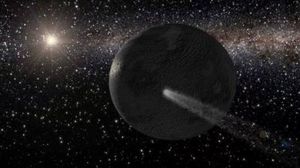
Two
teams of researchers who made national headlines in April for showing
the first evidence of water ice and organic molecules on an asteroid
have now discovered that asteroid 65 Cybele contains the same material.
Water
ice on asteroids may be more common than expected, according to a new
study that will be presented today at the world's largest gathering of
planetary scientists.
Two teams of researchers who made national headlines in April for
showing the first evidence of water ice and organic molecules on an
asteroid have now discovered that asteroid 65 Cybele contains the same
material.
"This discovery suggests that this region of our solar system contains
more water ice than anticipated," said University of Central Florida
Professor Humberto Campins. "And it supports the theory that asteroids
may have hit Earth and brought our planet its water and the building
blocks for life to form and evolve here."
Campins will present the teams' findings during the 42nd-annual
Division of Planetary Sciences Conference
(http://dps.aas.org/meetings/2010) in Pasadena, Calif., which concludes
Oct. 8.
Asteroid 65 Cybele is somewhat larger than asteroid 24 Themis - the
subject of the teams' first paper. Cybele has a diameter of 290 km (180
miles). Themis has a diameter of 200 km (124 miles). Both are in the
same region of the asteroid belt between Mars and Jupiter.
The academic article reporting this new finding has been accepted for publication in the European Journal "Astronomy and Astrophysics."
Campins is an expert on asteroids and comets. He received national attention for an article published in Nature showing
the first evidence of water ice and organic molecules on asteroid 24
Themis. He's also worked on several science missions with NASA and the
European Space Agency.
Campins holds degrees from the University of Kansas and the University
of Arizona. He joined UCF in 2002 as the Provost Research Professor of
Physics and Astronomy and head of the Planetary and Space Science Group.
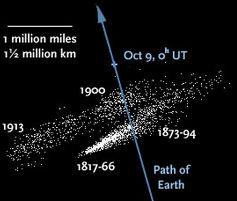
On
October 8, 2011, Earth will pass through several streams of particles
ejected over the past 200 years by Comet Giacobini-Zinner.
Everyone
enjoys a great meteor shower, those special times each year when a
profusion of shooting stars zip across the sky. So here's a head's up:
all of you should circle October 8th on next year's calendar.
This is the yearly date when Earth plows through a tenuous band of space
dust created by Comet Giacobini-Zinner along its orbit. Ordinarily, the
Draconid shower (formerly called the Giacobinids) puts on a so-so
celestial show, delivering about 20 meteors per hour if you can view
them under a moonless, pitch-black sky. That's hardly worth staying up
for: after all, from a similarly clear, dark site you'll see six or
seven random ("sporadic") meteors per hour.
However, this shower has a Jekyll-and-Hyde
personality. In 1933 and 1946 the Draconids dazzled skywatchers with
astounding meteor "storms" - delivering shooting stars at rates that
briefly topped 10,000 per hour! - because Earth crossed through a
particularly dense ribbon of debris shed by the comet in 1900. The
shower hasn't put on that kind of performance in the years since, though
in 2005 it surged unexpectedly to double or triple the usual rate.
If celestial prognosticators are right, we're in for a treat next year,
when Draconid rates could top 600 per hour - that's 10 per minute -
under ideal viewing conditions. That surge is in the cards because we'll
likely clip the stream of particles ejected in 1900. Odds are that it's
still largely intact, even though the comet's 6½-year-long orbit
periodically puts it in Jupiter's disruptive vicinity.
At a meeting of planetary scientists
now under way in Pasadena, California, meteor dynamicist Jérémie
Vaubaillon (IMCEE, France) put forth predictions that he'd calculated
with colleagues Mikiya Sato and Jun-ichi Watanabe (NAOJ, Japan). If
they're right, next October 8th Earth crosses some cometary debris shed
by Comet G-Z between 1873 and 1894, peaking at perhaps 60 meteors per
hour centered at 17:09 Universal Time, followed at 19:57 UT by a much
stronger, 600-per-hour pulse from the 1900 stream.
The rate is very uncertain, Vaubaillon admits, because there's no way to
know whether those earlier streams are still densely packed or have
been spread thin. Meteor observing wasn't as rigorous back then as it is
now. But next year's results should help disentangle which streams are
still contributing to the overall rates.
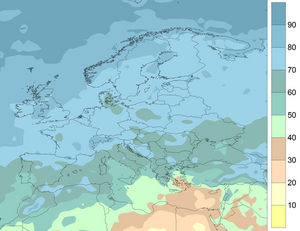
Although
Europe is favored for watching the 2011 Draconid meteor shower, this
map of average cloud cover during October suggests finding clear skies
might prove challenging. (Bluer hues denote more frequent clouds.)
Other meteor specialists are also struggling to come up with firm rates. In 2008
Sato and Watanabe independently estimated a maximum of 500 per hour
(at 20:36 UT), whereas NASA researchers Danielle Moser and William Cooke
have offered a more optimistic 800 per hour (at 19:11).
These times favor observers in Europe, but don't rush out to book a
plane just yet. First, the Draconid shower tends to produce many faint
meteors that'll be obliterated by a nearly full Moon that night.
Second, because the shower's radiant is way up near the head of Draco
(declination +54°), the best observing sites would likewise be
geographically north. But there's a reason that so few people book
vacations to Scandinavia in October: "Weather in Northern Europe is not
very pretty," notes Canadian meteorologist Jay Anderson. "October can be
very nice, but usually it is the time when the winter cloudiness begins
to encroach on the daily weather."
Instead, Anderson's cloud-cover map (at right) suggests that the
northernmost "good weather" spot is in the Greek Islands. "Santorini -
a favorite place of mine - has clear/few/scattered cloud cover 74% of
the time. I know where I'd go."
Great advice, Jay! Now, can you do something about that bright Moon?
Brian Vike
UnitedStatesUfo Blogspot
Sat, 09 Oct 2010 22:05 CDT
October 9, 2010 at 10:05 p.m. Two other friends and myself were
sitting outside when all 3 of us spotted a reddish-orange fireball
travel across the sky. It travelled a southwest to northeast direction.
At first we thought it was a meteor, but it never disappeared like
meteors do. There was no sound and there was only one. It looked like
what a plane might look like if it were on fire.
It appeared through the trees and went right over the top of us. We
watched it until we couldn't see it anymore, probably about 30 seconds.
It was very bright but it didn't blink. We have planes fly over all the
time heading to O-Hare to land. There were not blinking lights and we
can always hear the planes. This was probably about the same elevation
as the planes coming in for a landing but it wasn't anything any of us
have ever seen.
Shortly afterwards a plane did appear and we could hear it and see the
blinking lights. This was round in shape. I would love to know what we
saw.
If you have seen anything like this in the same area please be kind
enough to contact Brian Vike at: sighting@telus.net with the details of
your sighting. All personal information is kept confidential.
Comet 103P/Hartley 2 continues to put on a good show as it approaches
Earth for an 11-million-mile close encounter on Oct. 20th. Last night
it passed by the Double Cluster in Perseus. The contrast between the
blue stars of the two clusters and the green atmosphere of the comet was
remarkable:
Most
observers agree that the comet is not yet visible to the naked eye, but
it is an easy target for backyard telescopes. In recent nights,
astronomers have enjoyed watching Comet Hartley 2 pass a succession of
stars and deep-sky objects such as the Pacman nebula
and the Double Cluster. Next up is eta Persei (η Per), a 4th-magnitude
star that will shine through the comet's atmosphere on Oct 9th and 10th.
Details and a sky map are available from from Sky & Telescope.
More images: from Mike Broussard of Maurice, Louisiana; from David A Harvey of Tucson, Arizona; from Tamás Ábrahám of Zsámbék, Hungary; from Nick Howes using the 2 Metre Faulkes North Telescope in Hawaii; from Dr Paolo Candy of Ci.A.O. Cimini Astronomical Observatory - Italy; from Parks Squyres of SaddleBrooke, Arizona; from Gregg Ruppel of Ellisville, MO; from Geir Øye of Ørsta, Norway; from Mohammad Rahimi of Honjan - Esfahan - Iran; from Joe Wheelock of McDonald Observatory, Texas; from Alex Roca of Hortoneda Lleida Spain; from Fredrik Broms of Kvaløya, Norway; from Ehsan Rostamizadeh of Kerman, Iran; from Stefano Moretti of Ravenna, Italy; from Florin Marc of Tg.Mures, Romania
Camelopardalis
It's a strange-sounding name for a constellation, coming from the
Greco-Roman word for giraffe, or "camel leopard". The October
Camelopardalids are a collection of faint stars that have no mythology
associated with them -- in fact, they didn't begin to appear on star
charts until the 17th century.
Even experienced amateur astronomers are hard-pressed to find the
constellation in the night sky. But in early October, it comes to
prominence in the minds of meteor scientists as they wrestle with the
mystery of this shower of meteors, which appears to radiate from the
giraffe's innards.
The October Camelopardalids are not terribly spectacular, with only a
handful of bright meteors seen on the night of Oct. 5. It may have been
first noticed back in 1902, but definite confirmation had to wait until
Oct. 2005, when meteor cameras videotaped 12 meteors belonging to the
shower. Moving at a speed of 105,000 miles per hour, Camelopardalids
ablate, or burn up, somewhere around 61 miles altitude, according to
observations from the NASA allsky meteor cameras on the night of Oct. 5,
2010.
So they aren't spectacular. Their speed is calculated. Their "burn up" altitudes and orbits are known. So what's the mystery?
Camelopardalids have orbits -- see diagram at right -- which indicates
that they come from a long period comet, like Halley's Comet. But the
Camelopardalids don't come from Halley, nor from any of the other comets
that have been discovered.
Hence the mystery: somewhere out there is -- or was -- a comet that
passes close to Earth which has eluded detection. These tiny, millimeter
size bits of ice leaving pale streaks of light in the heavens are our
only clues about a comet of a mile, maybe more, in diameter.
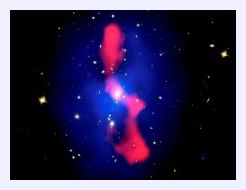
X-ray: NASA/CXC/ Univ. Waterloo/B.McNamara; Optical: NASA/
ESA/STScI/Univ. Waterloo/ B.McNamara; Radio: NRAO/Ohio Univ./L.Birzan et
al.
Composite image of a galaxy cluster in Camelopardus, located about 2.6 billion light-years away.
This
is why astronomers keep looking at the Camelopardalids meteors. They
hope that measuring more orbits may eventually help determine the orbit
of the comet, enabling us to finally locate and track this shadowy
visitor to Earth's neighborhood.
You can see the brief burst of a Camelopardalids meteor in this video here.
Tariq Malik
MSNBC / SPACE.com
Mon, 11 Oct 2010 16:04 CDT
It'll be a close one, but NASA says there's no chance of it hitting us
A small asteroid will zip close by Earth Tuesday (Oct. 12), but poses no
chance of hitting the planet or even entering the atmosphere, NASA has
announced.
The asteroid 2010 RD54 will fly within about 28,000 miles (45,000 km) of
Earth when it makes its closest pass at about 6:51 a.m. EDT (1051 GMT)
tomorrow morning, NASA spokesman D.C. Agle told SPACE.com.
The small asteroid is about 20 feet (6 meters) wide and expected to
drift silently by Earth instead of creating a dazzling fireball in the
atmosphere. The asteroid is too small to survive all the way to the
ground, even if it was aimed at Earth, scientists said.
"Small space rocks this size would burn up in our atmosphere & pose
no ground danger," NASA's Asteroid Watch group posted on Twitter.
Asteroid Watch is a public outreach effort by NASA's near-Earth
objects office at the Jet Propulsion Laboratory in Pasadena, Calif.
The group of scientists regularly posts asteroid flyby and sighting
alerts on Twitter under the name AsteroidWatch.
Asteroid 2010 RD54 may be visible to skywatchers with moderate
telescopes, but will be hard to spot, NASA officials said. Seasoned
asteroid hunters may be the best equipped to catch a glimpse, they
added.
"A moderate telescope required; it is very small," the Asteroid Watch group wrote on Twitter.
The asteroid will fly well inside the moon's orbit of Earth, and even
pass just above some of the highest satellites, which fly in
geostationary positions about 22,370 miles (36,000 km) above Earth. For
comparison, the International Space Station flies at an altitude of
about 220 miles (354 km).
When space rocks like Asteroid 2010 RD54 encounter Earth's atmosphere,
they can burn up in spectacular fire balls, but never reach the Earth.
Bigger asteroids about 460 feet (140 meters) wide can cause widespread
damage around their impact sites, but for global devastation much larger
space rocks would have to strike the Earth.
NASA routinely tracks asteroids and comets that fly near Earth, using a
network of ground and space telescopes as part of its Near-Earth Object
Observations program. According to the most recent report, the program
has tracked about 85 percent of the largest asteroids that fly near
Earth and about 15 percent of asteroids in the 460-foot class.
NASA is also planning to tackle a new space plan ordered by President
Obama to send astronauts to an asteroid by 2025. The mission, agency
officials have said, could help scientists better understand the
composition of asteroids and develop improved methods of deflecting them
before they endanger the Earth.
It's
a strange-sounding name for a constellation, coming from the
Greco-Roman word for giraffe, or "camel leopard". The October
Camelopardalids are a collection of faint stars that have no mythology
associated with them - in fact, they didn't begin to appear on star
charts until the 17th century.
Even experienced amateur astronomers are hard-pressed to find the
constellation in the night sky. But in early October, it comes to
prominence in the minds of meteor scientists as they wrestle with the
mystery of this shower of meteors, which appears to radiate from the
giraffe's innards.
The October Camelopardalids are not terribly spectacular, with only a
handful of bright meteors seen on the night of Oct. 5. It may have been
first noticed back in 1902, but definite confirmation had to wait until
Oct. 2005, when meteor cameras videotaped 12 meteors belonging to the
shower.
Moving at a speed of 105,000 miles per hour, Camelopardalids ablate, or
burn up, somewhere around 61 miles altitude, according to observations
from the NASA allsky meteor cameras on the night of Oct. 5, 2010.
So they aren't spectacular. Their speed is calculated. Their
"burn up" altitudes and orbits are known. So what's the mystery?
Camelopardalids have orbits - see diagram at right - which indicates that they come from a long period comet,
like Halley's Comet. But the Camelopardalids don't come from Halley,
nor from any of the other comets that have been discovered.
Hence the mystery: somewhere out there is - or was - a comet that passes
close to Earth which has eluded detection. These tiny, millimeter size
bits of ice leaving pale streaks of light in the heavens are our only
clues about a comet of a mile, maybe more, in diameter.
This is why astronomers keep looking at the Camelopardalids meteors. They hope that measuring more orbits may eventually help determine the orbit of the comet, enabling us to finally locate and track this shadowy visitor to Earth's neighborhood.
You can see the brief burst of a Camelopardalids meteor in this video.
Jamul - An East County Magazine reader asks, "I want to
know who else saw the blue and whitish-orange meteor I saw from my house
in Deerhorn Valley in Jamul at approximately 8:50 pm on Monday evening,
October 11."
The reader, who asked that her name not be published, added, "I saw it
when it was rather low--it had a head on it and had a pretty thick
tail.. .thicker than the meteors you usually see in a meteor shower. A
moment later the surrounding horizon on both sides lit up...From my
vantage point it looked like it was southeast, maybe in the area of Otay
Lakes or Dulzura."
Dennis Mammana, who pens the "Stargazer" syndicated column, told East County Magazine that the description does sound like a meteor and indicated that such sightings are more common than most people realize.
If you spotted the meteor or have a photograph, please contact editor@eastcountymagazine.org.
Hayley Collins
The Leader
Thu, 14 Oct 2010 11:54 CDT
It was described as looking like a plane on fire - or perhaps a tadpole.
Whatever it was, this distant object fired the imaginations of a father and daughter from Wrexham.
Jason Chandler and his daughter Jade were sitting on the rooftop terrace
at their home when they spotted a bright orange fireball.
The pair, of St Giles Court, near Belle Vue Park, could not believe their eyes.
Jason, 40, said: "We saw what looked like a white cloud in the
distance and as it went over Wrexham you could see that it was on fire.
"At first I thought it was a plane on fire. You could see the orange bit at the front.
"It looked like a tadpole, but as soon as it passed over you couldn't see the ball of fire anymore."
Ten-year-old Jade used her phone to take pictures of the amazing sight at about 6.30pm on Monday.
Jason says a vapour trial was clearly visible behind the
fireball and the whole thing lasted for about five minutes before it
disappeared from view.
"I know people think I'm mad, but I know what I saw and it was fantastic," he said.
"I'd love to know if anyone else saw it too."
Jason took up stargazing after moving into the St Giles Court property.
He said: "Since I've lived here I have started taking notice of things in the sky.
"It's the first time I have ever seen anything like that in my life, but
I knew straight away what it was. I saw two shooting stars after as
well."
After doing some research on the internet Jason believes he witnessed
the asteroid 2010 TD 54 that passed close to the earth on Tuesday.
Estimated to be around seven metres in diameter, it was discovered on
October 9 by the Catalina Sky Survey in Arizona during routine
monitoring.
But experts at Jodrell Bank Observatory in Cheshire say it could not be the TD 54.
Dr Tim O'Brien, an astro-physicist at the University of Manchester, said: "It can't possibly be the same asteroid.
"In space terms it did come relatively close to the earth, but it was
still 28,000 miles away and the atmosphere doesn't extend that far.
"You would need a telescope to see it because it's not visible with the naked eye."
Dr O'Brien suspects the pair witnessed a meteor.
"It's possible they did see a meteor burning up in the atmosphere.
"They are called fireballs and they do happen relatively often - you will see a bright one every few months."
Dr O'Brien added: "I have not had any other reports of one in the area, but it's perfectly plausible."
Anyone making their way home from traditional Saturday night
entertainments at the weekend may have thought the bright fireball
streaking through the skies above them was a sign of having too much of a
good thing.
The cause was actually a meteoroid, an orange-sized piece of a comet or
asteroid, burning up over Northern Ireland early last Sunday.
The ball entered the atmosphere above the north west at an estimated speed of 20 to 30 km per second at about 0232 BST.
Armagh Observatory received many telephone and internet reports from members of the public reporting sightings of the meteoroid.
Scientists at the observatory said that, due to the object's speed,
friction with the Earth's atmosphere caused its surface layers to burn
off, producing a bright light in the sky.
Luminous
As it entered further into the atmosphere, denser air caused it to begin
to disintegrate, producing bright flares which lit up most of the sky
and may also have illuminated the ground.
A luminous trail of material, vivid green due to magnesium and iron in the meteoroid, was briefly left behind in the sky.
The object completely disintergrated at about 70 to 80 km above the ground.
The whole event only lasted several seconds and was captured by the
Armagh Observatory meteor cameras, which have been recording meteor
activity on the night sky since 2005.
The scientists said that the speed and direction of the meteoroid
suggest it may have been a piece of a comet called 21P/Giacobini-Zinner.
This comet orbits the sun every six and a half years. Its dust-and-ice nucleus is believed to be about two km in diameter.
The material shed by the comet every time it swings by the Sun produces a
meteor shower known as the Draconids, which peaks in activity towards
the end of the first week of October.
For backyard stargazers, the next few nights are the best time to see
green Comet 103P/Hartley 2 as it approaches Earth for an
11-million-mile close encounter on Oct. 20th. Set your alarm for the
dark hours before dawn, go outside, and look straight up. You will find
Hartley 2 not far from the bright star Capella: sky map.
Although the comet is barely visible to the unaided eye, it is easy to
find in binoculars and looks great through a backyard telescope.
Doug Zubenel sends this picture (Oct. 9) from the Monument Rocks National Landmark in Kansas:
"To photograph the comet, I used a Canon Rebel XTi digital
camera with an 85mm Nikkor lens," says Zubenel. "This picture is a
single 2-minute exposure begun with the lens focused on the rocks, with a
quick flash, then focus-shifted to infinity for the remainder of the
time at ISO 800."
NASA scientists say 103P/Hartley 2 is one of the most active comets
they've seen; it has a big atmosphere and copious outgassing from jets
in the nucleus. Amateur astronomers are encouraged to monitor the action
and submit their images here.
More images: from Rolando Ligustri using a robotic telescope in New Mexico; from Mike Broussard of Maurice, Louisiana; from Fredrik Broms of Kvaløya, Norway; from Tamás Ábrahám of Zsámbék, Hungary; from Efrain Morales Rivera of Aguadilla, Puerto Rico; from P-M Hedén of Vallentuna, Sweden; from Nick Howes using the Faulkes North Telescope in Hawaii.
His research indicates asteroids are like bombs
For years, astronomers have been on the lookout for large asteroids on a
collision course with Earth. Now, a scientist at Sandia National Labs
is warning about the danger of smaller asteroids that could burst in the
atmosphere with the power of a nuclear explosion.
Mark Boslough says more money, attention, and telescopes need to be focused on finding small asteroids.
Boslough bases his finding, partly, on a small asteroid around 100 feet
in diameter that burst over the remote Tunguska region in Russia back in
1908. It left 700 square miles looking like a wasteland.
"This can happen at anytime," Boslough said. "There are millions of objects about the size of the Tunguska object."
He says most small asteroids are only detected when they are close to
Earth, too late to try to deflect. However, with better searching,
Boslough believes astronomers could potentially find something like a
small asteroid weeks before an impact.
That would give any area in line of the impact, enough time to evacuate.
The probability of a small asteroid hitting is one in a thousand years. But, Boslough says it's best to be prepared.
Fireball or contrail at sunset? Flaming object caught on camera in Canada
1RisenSon, Youtube
Sat, 16 Oct 2010 12:21 CDT
Was in my home and saw out my window two flashes in the sky.
Beautiful bright orange in color and over the lake. May have been
asteroids...you tell me. Saw two in the western sky over Lake Opechee in
Laconia, New Hampshire at exactly 5:00 PM EST. By the time I got my SLR
6 megapixel camera one had vanished. Took twelve successive shots from
my porch through an open window till the second one vanished. I was very
excited to have seen two and photographed one.
For a better view of the object see here.
A
junior version of the famous Perseid meteor shower thought to have
originated from the remains of Halley's Comet will hit its peak over the
next week, but the light of the moon may intrude on the sky show.
This upcoming meteor display is known as the Orionids because the
meteors seem to fan out from a region to the north of the Orion
constellation's second brightest star, ruddy Betelgeuse.
The annual event peaks before sunrise on Thursday (Oct. 21) but several
viewing opportunities arise before then for skywatchers in North
America. [Where to look to see the Orionids]
The shooting stars are created by small bits of space dust - most no
larger than sand grains - thought to be left over from the famed
Halley's Comet, which orbits the sun once every 76 years.
Currently, Orion appears ahead of us in our journey around the
sun, and has not completely risen above the eastern horizon until after
11 p.m. local daylight time.
The constellation is at its best several hours later. At around 5 a.m. -
Orion will be highest in the sky toward the south - Orionids
typically produce around 20 to 30 meteors per hour under a clear, dark
sky.
But skywatchers beware: You will be facing a major obstacle in your
attempt to observe this year's Orionid performance. As bad luck would
have it, the moon will turn full on Oct. 23. Bright moonlight outshines
fainter meteors, seriously reducing the number anyone can see.
The gradual build up to the full moon will hamper - if not outright
prevent - dark-sky observing during the Orionid meteor shower's peak
on Oct. 21.
The Orionids are actually already underway, having been active only in a
very weak and scattered form since about Oct. 2. But a noticeable
upswing in activity is expected to begin around Oct. 17, leading up to
their peak night.
"Orionid meteors are normally dim and not well seen from urban
locations," notes meteor expert, Robert Lunsford, adding that "it is
highly suggested that you find a safe rural location to see the best
Orionid activity."
Damage control for 2010
With all this as a background, perhaps the best times to look this year
will be during the predawn hours several mornings before the night of
full moon. That's when the constellation Orion (from where the meteors
get their name) will stand high in the northeast sky.
In fact, three "windows" of dark skies will be available between moonset
and the first light of dawn on the mornings of Oct. 18, 19 and 20.
Generally speaking, there will be about 150 minutes of completely dark
skies available on the morning of the 18th.This shrinks to about 100
minutes on the 19th, and to about 50 minutes by the morning of the 20th.
This skywatching table shows prime Orionid meteor shower viewing times for some select U.S. cities.
In the table, all times are a.m. and are local daylight times. "Dawn"
is the time when morning (astronomical) twilight begins. A "Window" is
the number of minutes between the time of moonset and the start of
twilight.
For example: When will the sky be dark and moonless for Orionid viewing on the morning of Oct. 20 from Houston?
Answer: There will be a 50-minute period of dark skies beginning at
moonset (5:16 a.m.) and continuing until dawn breaks (6:06 a.m.).
Perhaps up to a dozen forerunners of the main Orionid display might
appear to steak by within an hour's watch on these mornings,
particularly on the 20th, the morning before the peak. It might even be
worthwhile to try on Thursday morning, Oct. 21, although for most
places, the moon will not set until just after the first light of dawn.
Halley's legacy
In studying the orbits of many meteor swarms, astronomers have found that they correspond closely to the orbits of known comets.
The Orionids are thought to result from the orbit of Halley's Comet, as
some of the dust that has been shed by this famous object intersect
earth's orbit around the sun during October.
There are actually two points along Halley's path, where it comes
relatively near to our orbit. Another one of these points occurs in
early May causing a meteor display from the constellation Aquarius, the
Water Carrier.
The tiny particles that are responsible for the Orionid and Aquarid
meteors are - like Halley itself - moving through space in a
direction opposite to that the earth. This results in meteors that ram
through our atmosphere very swiftly at 41 miles (66 km) per second. Of
all the meteor displays, only the November Leonids move faster.
Orionid postmortem
After the peak, activity will begin to slowly descend, although most of
the meteors will be squelched by the light of the moon. Rates drop back
to around five per hour around Oct. 26. The last stragglers usually
appear sometime around Nov. 7.
It is indeed unfortunate that the Moon will likely obliterate most of
the Orionids in the nights following the peak, but the viewing odds will
be much better before the break of dawn on those mornings leading up to
the peak. Almost certainly, you should sight at least a few of these
offspring of Halley's Comet as they streak across the sky.
In the absence of moonlight a single observer might see at least a
couple of dozen meteors per hour on the morning of the peak, a number
that sadly can not be hoped to be approached in 2010. In fact, it
appears that this year, fans of the Orionids will be uttering the same
lament that the old Dodger fans in Brooklyn used to: "Wait till next
year!"
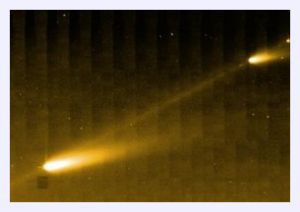
Aboriginal culture includes a colourful history of comets in the Australian skies.
Australia's first people viewed comets as portents of doom, a new study of Aboriginal astronomy has found.
Writing on the pre-press website arXiv.org,
Duane Hamacher from Sydney's Macquarie University who led the research,
says Aboriginal people developed an extensive culture regarding the
night sky with stories and detailed observations.
"Different Aboriginal groups had different seasons linked to certain
stars which correlated to the availability of certain food sources, or
when Indonesian fishermen would come to trade," says Hamacher.
"Aboriginal societies typically associated comets with fear, death,
omens of sickness, malevolent spirits and evil magic, which is
consistent with many other cultures around the world."
The oral tradition
Hamacher examined 25 accounts of comets from 40 Aboriginal communities
citing both supernatural perceptions and historical accounts.
"While the description and location of some stories in the 19th and 20th
centuries can be linked to actual historical events, others don't
correspond to any particular comet," he says.
Hamacher managed to find Aboriginal accounts for about half a dozen major comets including events in 1843, 1844 and 1861.
"In fact, there were a lot in the 1800s and a couple up to 1910 and
1927. The March 1843 comet was easy to identify, but others involved
very general descriptions, so you had to try and figure out what comet
they were talking about."
"In 1901 locals on Cape York Peninsula spoke about a fire lit by two old
women. A year earlier a very bright comet was seen in that latitude
with two distinct tails and the head pointing down just below the
horizon."
"It's not definitive that it's the comet they were talking about, but
the description certainly seems to indicate it," says Hamacher.
Several Aboriginal groups saw comets as smoke, which is also how the New
Zealand Maori and some native South American people saw them,
especially if the comet was angled off the horizon with the tail flowing
upwards looking like smoke.
Hamacher says one of the difficulties in researching Aboriginal
astronomy is finding people who know the stories associated with
individual comet events. A problem made more difficult when researching
events prior to the 1800s.
"Much of the oral history has been lost, especially near British
colonies, entire cultures, including the language, customs, and oral
traditions, were virtually destroyed," says Hamacher.
"Another common theme in several Aboriginal groups involved comets
representing bundles of spears, while meteors were spears being hurled."
Rock art
Rock art and paintings were the other primary method of passing on
stories about comets in Aboriginal culture, but Hamacher says this can
be quite speculative.
"There is a place called comet rock in the Kimberley with pictures that
look like a comet and there were stories about a star with trails that
fell out of the sky into the ocean, causing massive tsunamis."
"There are also rock engravings around Sydney showing Aboriginal heroes
wearing head dress. But there's some debate that it could be bundles of
spears instead."
"Because of the association between spears and comets, and because the
engravings also show the Sun and the Moon, it's possible they represent
comets, but that's going to take further research."
Hamacher says the only way to know for certain is to talk with the traditional owners.
"But where the cultures have been damaged, those stories have been lost,
so you're only left with the archaeological evidence, and that can be a
real challenge."
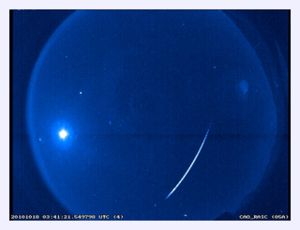
A 2010 Orionid meteor, seen over Western Ontario, Canada. A waxing gibbous moon shines brightly at the left side of the image.
The most famous of all comets, Comet Halley is noted for producing
spectacular displays when it passes near Earth on its 76-year trip
around the sun. However, you don't have to wait until 2061 to see a
piece of the comet -- you can do it this very week!
Halley's Comet leaves bits of itself behind -- in the form of small
conglomerates of dust and ice called meteoroids -- as it moves in its
orbit, which the Earth approaches in early May and mid-October. When it
does, it collides with these bits of ice and dust, producing a meteor
shower as the particles ablate -- or burn up -- many miles above our
heads. The May shower is called the Eta Aquarids, as the meteors appear
to come from the constellation Aquarius. The October shower has meteors
that appear to come from the well-known constellation of Orion the
Hunter, hence the name: Orionids.
Orionids move very fast, at a speed of 147,300 miles per hour. At such
an enormous speed, the meteors don't last long, burning up very high in
the atmosphere. Last year, the NASA allsky cameras at Marshall Space
Flight Center in Huntsville, Ala., and in Chickamauga, Ga., recorded 43
definite Orionid meteors. Most of these appeared at an altitude of 68
miles and completely burned up by the time they were 60 miles above the
ground, seen in the graph at right.
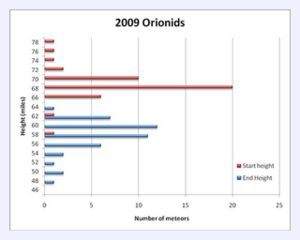
Chart showing Orionid meteor ablation -- or "burn-up" -- altitudes.
Even though the peak isn't until October 21, the shower is going on
now. The NASA camera systems saw their first Orionid on Oct. 15.
Unfortunately, the light from the nearly full moon will wash out the
fainter meteors, so expect to see fewer than the 30-per-hour rate you
might see under completely dark skies.
The good news is that watching Orionids is easy. Go out into a clear,
dark sky after 11 p.m. at night -- your local time -- and lie on a
sleeping bag or lawn chair. Look straight up. After a few minutes, your
eyes will become dark-adapted, you'll start to see meteors. Any of these
that appear to come from Orion will be an Orionid, and therefore
represent a piece of Halley's Comet doing its death dive into our
atmosphere.
Most folks would consider seeing one or two of these a fair exchange for an hour or so of time. :)
Click here
to watch a video of the bright Orionid meteor streaking over Western
Ontario on Oct. 17, 2010. The bright object to the left side of the
screen is the waxing gibbous moon:
Leonard David
SPACE.com
Tue, 19 Oct 2010 13:58 CDT
A
new report calls on NASA to establish a Planetary Defense Coordination
Office to lead national and international efforts in protecting Earth
against impacts by asteroids and comets.
The final report of the Ad-Hoc Task Force on Planetary Defense of the
NASA Advisory Council was delivered to the Council this month, proposing
five recommendations that suggest how the space agency should organize,
acquire, investigate, prepare, and lead national and international
efforts in planetary defense against near-Earth objects.
"This was a very important step in the process of the United States
Government defining its role in protection of life from this occasional,
but devastating natural hazard," former astronaut Russell Schweickart
told SPACE.com. "Happily, in the instance of asteroid impacts,
this is a natural disaster which can be prevented...only, however, if
we properly prepare and work together with other nations around the
world."
Schweickart, who served as co-chair of the task force, said the new
report and its recommendations to NASA combined new information with
previous studies from the past decade.
The task force met in July to discuss the need for a planetary defense
office at NASA. Their final report was submitted to the space agency on
Oct. 6.
"With the support of the Administration and the Congress, the U.S. will
be in the position of being able to work with and provide leadership in
protecting life on Earth from these preventable cosmic disasters," he
said.
The task force's five recommendations are:
- Organize for Effective Action on Planetary Defense: NASA should
establish an organizational element to focus on the issues, activities
and budget necessary for effective planetary defense planning; to
acquire the required capabilities, to include development of
identification and mitigation processes and technologies; and to prepare
for leadership of the U.S. and international responses to the impact hazard. - Acquire Essential Search, Track, and Warning Capabilities: NASA
should significantly improve the nation's discovery and tracking
capabilities for early detection of potential NEO impactors, and for
tracking them with the precision required for high confidence in
potential impact assessments. - Investigate the Nature of the Impact Threat: To guide
development of effective impact mitigation techniques, NASA must acquire
a better understanding of NEO characteristics by using existing and new
science and exploration research capabilities, including ground-based
observations, impact experiments, computer simulations, and in situ
asteroid investigation. - Prepare to Respond to Impact Threats: To prepare an adequate
response to the range of potential impact scenarios, NASA should conduct
a focused range of activities, from in-space testing of innovative NEO
deflection technologies to providing assistance to those agencies
responsible for civil defense and disaster response measures. - Lead U.S. Planetary Defense Efforts in National and
International Forums: NASA should provide leadership for the U.S.
government to address planetary defense issues in interagency, public
education, media, and international forums, including conduct of
necessary impact research, informing the public of impact threats,
working toward an internationally coordinated response, and
understanding the societal effects of a potential NEO impact.
Funding needs
The seven-person Ad Hoc Task Force on Planetary Defense was established
in April and reported to the NASA Advisory Council. The NAC provides the
NASA Administrator with counsel and advice on programs and issues of
importance to the space agency.
The NASA Advisory Council has approved the task force report. However,
there's still a long way to go in the sense that there is no obligation
on the part of the NASA Administrator to follow the recommendations.
Still, the seven-person team writing the report has elevated the NEO
issue, helping to better identify how NASA should further address
planetary defense.
The task force was chaired by Schweickart and fellow former astronaut
Thomas Jones, with other members representing academia, a space research
institute, and NASA itself.
In the final report, the task force found that a planetary defense
program plan is likely to require an annual budget of approximately $250
million to $300 million per year during the next decade.
That funding would be needed to meet the Congress-mandated search goal
of spotting 460-feet (140-meter) wide NEOs, as well as to execute
selected NEO characterization missions; develop and demonstrate NEO
deflection capabilities; and develop the analytic and simulation
capacity necessary for NASA's planetary defense role.
"Once the search for potentially hazardous objects is substantially
complete, the task shifts to ongoing monitoring and catalog
maintenance," the report states.
After flight demonstrations of the primary deflection concepts are
completed, further experiments would be integrated into scientific or
exploration missions. The planetary defense program budget could then
recede to operations and maintenance levels, approximately $50 million
to $75 million annually, the report explains.
The task force report "strongly recommends" that the cost of NASA
planetary defense activities be explicitly budgeted by the
administration and funded by the Congress as a separate agency budget
line, not diverted from existing NASA science, exploration, or other
mission budgets.
Driving philosophy
As explained in the task force report, the "driving philosophy" behind
the national and international defense against NEOs should be, "find
them early."
Early detection of NEOs - especially those larger than 140 meters in
size - is key to mounting an effective and cost-effective planetary
defense effort. An adequate search, detection and tracking capability
could find hazardous objects several years or decades before they
threaten impact.
Early detection and follow-up tracking of hazardous NEOs eliminates any
need for a standing defense capability by mission-ready deflection
spacecraft with their high attendant costs, the report points out.
While the task force report underscores the importance of NASA taking a
leadership role in planetary defense, there's no obligation by NASA
leadership, or the White House to follow the recommendations.
The next shoe to drop on dealing with the NEO issue is expected to come
mid-month by the White House Office of Science and Technology Policy. It
has been deliberating on how best the U.S. government should move out
on in-coming NEOs hazardous to Earth.
A newly-discovered comet is diving toward the sun. Chinese comet
hunter Bo Zhou found it on Oct. 19th in SOHO coronagraph images. The
comet is faint now, but it should brighten in the hours ahead as it
heats up. To see it, first check the finder chart, then play the movie. That tadpole is a doomed comet. Updates will be posted as the view improves.
NASA advisory council recommends establishment of new agency to protect planet from cometary bombardment
United Press International
Tue, 19 Oct 2010 04:44 CDT
Washington
- NASA should establish a Planetary Defense Coordination Office to lead
efforts should the Earth be threatened by asteroids and comets, a U.S.
report says.
The report, by the Ad-Hoc Task Force on Planetary Defense of the NASA
Advisory Council, offers suggestions on how the agency should prepare to
lead national and international plans for defending Earth from
collisions from near-Earth objects, SPACE.com reported Tuesday.
"This was a very important step in the process of the United States
government defining its role in protection of life from this occasional,
but devastating natural hazard," former astronaut Russell Schweickart,
co-chairman of the task force, said.
"Happily, in the instance of asteroid impacts, this is a natural
disaster which can be prevented ... only, however, if we properly
prepare and work together with other nations around the world."
The task force, led by Schweickart and fellow former astronaut
Thomas Jones, included members from academia, a space research institute
and NASA itself.
The "driving philosophy" behind the national and international defense
against near-Earth objects, the report said, should be to "find them
early."
Early detection is paramount in mounting an effective and cost-effective planetary defense effort, the report said.
For backyard stargazers, now is the best time to see green Comet
103P/Hartley 2 as it approaches Earth for an 11-million-mile close
encounter on Oct. 20th. Set your alarm for the dark hours before dawn,
go outside, and look straight up. You will find Hartley 2 not far from
the bright star Capella: sky map.
Although the comet is barely visible to the unaided eye, it is easy to
find in binoculars and looks great through a backyard telescope.
Rolando Ligustri has been observing the comet nightly using a robotic 4-inch telescope in New Mexico.
Many
readers have asked, why is the comet green? Answer: Hartley 2's green
color comes from the gases that make up its Jupiter-sized atmosphere.
Jets spewing from the comet's nucleus contain cyanogen (CN: a poisonous
gas found in many comets) and diatomic carbon (C2). Both substances glow
green when illuminated by sunlight in the near-vacuum of space.
NASA scientists say
103P/Hartley 2 is one of the most active comets they've seen, with
copious outgassing from jets in the nucleus. Amateur astronomers are
encouraged to monitor the action and submit their images here.
More images: from Nick Howes of Cherhill, Wiltshire, UK; from Abe Schwartz of San Juan, Puerto Rico; from Dr Paolo Candy of Ci.A.O. Cimini Astronomical Observatory - Italy; from John Chumack of Dayton, Ohio; from Keith Johnson of Durham, England,UK; from Joao Porto of Ponta Delgada, Azores islands, Portugal
The
most illustrious meteorite in history continues to inspire heated
debate. Does it carry microbial fossils from Mars or are its strange
features just the product of some unique geochemistry? After almost 20
years, dueling papers are still coming out, and the opposing parties are
no closer to a resolution.
Most scientists agree that the meteorite ALH84001 is the oldest meteorite ever found to have come from Mars.
"The meteorite is so old that if Martian life existed back then, it
probably floated by the rock at some point," says Timothy Swindle of the
University of Arizona. "But did it leave any record?"
In 1996, one research group claimed yes, sending shock waves through the
scientific community and beyond. President Bill Clinton made a special
address on the apparent discovery, and the media widely broadcasted the
scientists' images of what appeared to be dead "bug" remains from the
rock. Had we finally met our neighbors?
The iconic meteorite became the grist for many imaginations. The TV show
The X-files depicted an ALH84001 look-a-like with live bugs in it, and a
Dan Brown novel imagined a conspiracy to cover-up extraterrestrial
evidence from a space rock.
Biopic of a falling star
The meteorite made its debut in 1984, when it was picked up by a
geologist team riding snowmobiles through the Allan Hills region of
Antarctica. It took 10 years for researchers to realize this 4-pound
specimen likely came from Mars.
The general consensus now is that the original rock formed 4 billion
years ago on Mars. It was eventually catapulted into space by an impact
and wandered the solar system for millions of years before landing on
Earth 13,000 years ago.
Over 50 other meteorites have been identified as coming from Mars, but
ALH84001 is by far the oldest, with the next in age being just 1.3
billion years old.
"That alone makes ALH84001 a very important sample," says Allan Treiman
of the Lunar and Planetary Institute. "It's our only hope to understand
what Mars was like at this time period."
The first thing that struck researchers examining the meteorite was the
presence of 300-micron-wide carbonate globules that make up 1% of the
rock. Dave McKay from NASA's Johnson Space Center and his colleagues
determined that the carbonate most likely formed in the presence of
water.
Although
evidence for a wet ancient Mars has accumulated in the subsequent
years, the claim that ALH84001 once sat in water was pretty
revolutionary at the time, says Kathie Thomas-Keprta, also from the
Johnson Space Center.
Inside the ALH84001 carbonates, McKay spotted odd features that
resembled very small worm-like fossils, so he asked Thomas-Keprta to
look at them more closely with electron microscopy.
"I kind of thought he was crazy," she says. "I thought I would join the group and straighten them out."
In the end, she helped the team characterize the biomorphic features, as
well as unusual grains of the mineral magnetite found in the meteorite.
In a 1996 Science paper, these two phenomena - along with
the chemical distribution in the globules and the detection of large
organic molecules - were taken collectively as signatures of
biological activity occurring long ago on Mars.
The storyline unravels
However, skeptics began to pick apart the four lines of evidence presented in the 1996 paper.
Groups of geologists and chemists proposed alternative ways that the
carbonate globules and the organic molecules could have formed without
the need of Martian microbes.
The supposed fossil shapes were so small they could only have been the
remains of hypothetical "nanobacteria." A more plausible explanation,
according to other researchers, was that the tiny artifacts are uneven
patches in the coating used to prepare the samples for electron
microscopy.
That left the magnetite grains as the strongest case for a biologic imprint in ALH84001.
"The focus of the last 10 years has been the magnetite," says Thomas-Keprta.
Microbial compasses

A chain of magnetite crystals, "like a string of pearls,” within meteorite ALH 84001. Arrows indicate the ends of the chain.
Magnetite
(Fe3O4) is a common mineral found on black sandy beaches, in iron-rich
sediments and even in interplanetary dust. The majority of this
magnetite forms in geologic processes, where many elements mix together
and iron often gets replaced with iron-like elements such as magnesium
and chromium.
However, the magnetite grains found in the carbonate globules of ALH84001 have very few of these sorts of substitutions.
"I had never seen magnetite as chemically pure as this before," Thomas-Keprta says.
But when she looked through the literature, she realized that chemically
pure magnetite is known from biology. So-called magnetotactic bacteria
create a chain of magnetite grains to help orient themselves in their
search for nutrients. Iron makes for a stronger magnet, so the bacteria
are very selective when they form their magnetite compasses. They also
build grains of a uniform size (roughly a tenth of a micron) that
optimizes the magnetic response.
"The size and purity of the magnetite is controlled by the organism to be the best magnet it could be," Thomas-Keprta says.
In 2001, she and her colleagues showed that many of the same properties
in biologically-derived magnetite are reproduced in the grains from
ALH84001. The conclusion was that Martian microbes once used magnetite
for the same purpose as terrestrial ones do.
Treiman agrees that the ALH84001 magnetite is unlike
geologically-produced magnetite found on Earth. "But everything else
about this meteorite is unique," he argues. "There comes a point where
being unique is not unique."
It's improbable that Martian microbes deposited magnetite grains
directly in the rock, so Thomas-Keprta and her colleagues have to argue
that the magnetite formed outside of the rock and washed in. They also
have to assume that Mars had a much stronger magnetic field in the past
so that building an intracellular magnetic compass would be an
advantage.
Treiman and others argue that the magnetite could be explained more
easily with some sort of shock event that heated the carbonate enough to
allow magnetite grains to form. Thomas-Keprta says these abiotic models
are fatally flawed. The problem is in the cooling time. If the rock
cools too fast, the magnetite ends up full of impurities. Too slow and
the surrounding carbonate becomes too uniform.
"They are looking for a single event that can account for all the
magnetite," Thomas-Keprta says. "But no natural or laboratory
synthesized analogs proposed have yet to reproduce the chemical and
physical properties observed in the ALH84001 carbonate-magnetite
assemblages."
She and Treiman went head to head at a recent Lunar Planetary Society Conference. Neither side has relented.
"Naysayers are always going to be naysayers," Thomas-Keprta says. "But I hope people on the fence will look at the evidence."
Polling the community
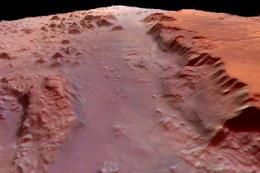
Researchers
believe that the Allan Hills meteorite was blasted out of Eos Chasma on
Mars, near the far horizon in this Mars Express image. The canyon feeds
into the larger Valles Marineris canyon.
Treiman
thinks that the issue is probably settled for most of his colleagues. "I
am one of the few holdovers still arguing about it," he says. "I can't
move on."
The debate may not be settled anytime soon. Treiman isn't sure how one
could ever entirely rule out that Martians might have had a hand in
forming ALH84001. "Nature is infinitely complicated," he says. "It is
always surprising us."
However, he believes the alternative explanations from geology and
chemistry are simpler, since they don't require inventing the whole new
science of Martian biology. Scientists are trained to pick the simplest
explanation.
An informal poll of more than 100 scientists by Swindle in 1997, right
after the first announcement of possible biological relics in ALH84001,
showed that most of the community was already hedging their bets. The
typical response gave about even odds that Mars once had life but said
that there was just a 1-in-5 chance that McKay's group had found the
smoking gun.
A few years later, Swindle tried to do the poll again but couldn't get
enough respondents to form a representative sample. He thinks most
people had made up their mind that ALH84001 did not carry biosignatures
from Mars. But that doesn't mean that sifting through the meteorite
hasn't been worth it.
"It was good science," he says. "It challenged people to really think about what would count as evidence of life on Mars."
Lee Labuschagne
Digital Journal
Sat, 23 Oct 2010 14:46 CDT
How would the world react to the threat of an asteroid impact?
This is the topic of a three-day workshop on Near-Earth Objects (NEOs)
and the dangers they present, that will be held in Darmstadt, Germany
next week.
An ESA statement
says The high-level Mission Planning and Operations Group (MPOG)
workshop is the latest in a series organised to report to the UN
Committee on the Peaceful Uses of Outer Space and includes
representatives from major space agencies, NASA astronauts, the Secure
World Foundation and the Association of Space Explorers.
"The workshop series is focusing on plans and recommendations for global
coordination and response in the event that an asteroid or other object
is found to pose an impact threat to Earth," says workshop coordinator
Detlef Koschny from ESA.
Plausible asteroid impact and timing scenarios
Participants will review the latest information and findings from
asteroid and NEO research worldwide, and receive briefings on activities
of the Inter-Agency Debris Coordination Committee and ESA's Space
Situational Awareness Preparatory Programme. They will also consider two
theoretical but plausible impact scenarios and analyse them in detail
in order to identify the best strategy for global response.
In addition to senior managers from ESA, NASA, the Russian space
agency Roscosmos and numerous national space agencies, participants will
include prominent researchers in the field such as Rusty Schweickart
(Apollo 9 astronaut and Head of ESA's Committee on NEOs), Thomas Jones,
(NASA astronaut on four Space Shuttle flights and a long-time asteroid
impact researcher), Brian Weeden (Technical Advisor at the Secure Word
Foundation) and Sergio Camacho, (former Director of the UN Office for
Outer Space Affairs and now Secretary General of the Regional Centre for
Space Science and Technology Education for Latin America and the
Caribbean).
The workshop's finding will later be merged with findings of other
experts to create a final report to the UN committee. Such a report will
recommend how to react to an impact threat.
Under ESA's Space Situational Awareness Preparatory Programme, Europe is
acquiring the capability to watch for objects and natural phenomena
that could harm satellites in orbit or facilities on the ground.
Webcast:
A media briefing after the workshop will be webcast on 29 October,
13:00-14:30 CEST (GMT+2). The video stream will be available at here.
Dennis Cox
A Catastrophe of Comets blog
Sun, 24 Oct 2010 12:35 CDT
When
I first started with all this, my intention was to see if I could
figure out a better way to scope out new, undocumented craters, or
likely places to go meteorite hunting. I didn't do so well at first. But
ironically, when I quit looking for new craters, and started focusing
on identifying formations of airburst melt, I began to find too many new
craters to count...
Literally too many to count. And a little bit of everything in between.
Even if I had the funding, I could never visit them all. I need help. So
over the next few weeks, I am going to post a few new craters a day, in
the hope that someone might live close enough, or have interest enough,
to go get a closer look. Each place will be presented as is. And with
little, or no comments. I may not be able to go there, and do field
work. But I can still point, and grunt. You be the judge.
Don't surprised if you find others nearby any given crater. Few of them fell alone.
This first one is at 31.347399, - 105.364137. And it is about 70 miles southeast of El Paso Texas.
Down below is really a bizarre UFO sighting, which was videotaped over Moscow, Russia on October 18, 2010.
Jeremy Hsu
LiveScience
Wed, 27 Oct 2010 07:20 CDT
An asteroid splashdown in one of Earth's oceans could trigger a
destructive chemical cycle that would wipe out half the ozone layer,
according to a new study. The massive loss of protection against the
sun's ultraviolet (UV) radiation would likely force humans into a
vampire-style existence of staying indoors during daylight hours.
The worst scenario based on an asteroid 0.6 miles (1 kilometer) wide would re-create the hole in the ozone layer,
which appeared over Antarctica during the 1990s, except this would be
worldwide. UV levels in the study's simulation soared beyond anything
measured so far on Earth by the UV Index's daily forecasts of
overexposure to UV radiation, and remained that way for as long as two
years.
"An asteroid impact in the ocean is
always dismissed as being a danger for coastal sites, but not much else
has been discussed about it," said Elisabetta Pierazzo, a senior
scientist at the Planetary Science Institute in Tucson, Ariz. "I was
looking at the asteroid hazard from climatic effects.
"To do that, Pierazzo combined her expertise in crater-impact modeling
with simulations developed by U.S. and German atmospheric scientists
that show the interactive chemistry of the atmosphere. They tested
scenarios with a 0.6-mile asteroid and a 0.3-mile asteroid (500 meters)
at a specific location and specific time of year.
They had no idea what to expect.
Breaking bad
The models showed how ozone destruction would result from an asteroid
strike launching seawater vapor hundreds of miles up into the highest
parts of the atmosphere. Chemical elements such as chloride and bromide
that separated from the water vapor could then wreak havoc by destroying
the ozone layer that protects life on Earth from the worst of mutation-causing UV rays.
"The thing with the asteroid is that it ejects the water vapor way up
there - we're talking hundreds of kilometers," Pierazzo told
LiveScience in a phone interview. "It really goes to the highest extent
of the atmosphere."
Model results showed a 0.3-mile asteroid that hit at a latitude 30
degrees north in the Pacific Ocean in January would lead to a local
impact on the ozone layer - though "local" still meant an ozone hole
that spread across the entire Northern Hemisphere. By contrast, the
0.6-mile asteroid strike led to a worldwide drop in UV protection - at
which point the "hole" ceases to be a hole.
Location of the asteroid strike matters because of atmospheric
circulation patterns, Pierazzo explained. Time of year in each
hemisphere also matters, because the strength of the ozone layer changes
by season based on the amount of sunlight reaching the atmosphere. (In
the upper atmosphere, ozone (O3) forms when oxygen molecules are broken
apart by the sun's UV light.)
A strike by the 0.3-mile asteroid saw a jump in ultraviolet radiation as
measured by the ultraviolet index (UVI) to values above 20 in the
northern subtropics for several months. Normally, a UVI of 10 or more
can burn people with fair skin with just a few minutes of sun exposure,
and some of the highest recorded UVI values on Earth (around the
equator) have reached just 18. On certain days, a UVI of 20 was recorded
at a high-altitude desert in Puna de Atacama, Argentina.
A strike by the larger of the two model asteroids boosted UVI values
above 20 within a 50-degree latitude band north and south of the equator
for about two years. Some areas within the band saw UVI spikes as high
as 56. That band's northern end would include cities such as Seattle and
Paris, while the southern end would extend into cities within countries
such as New Zealand, Chile and Argentina.
Long-term effects of such high UV radiation would include
skin-reddening, changes in plant growth and genetic mutations for humans
and other organisms.
The future threat
Such scenarios represent the likelier outcomes of an asteroid impact on
Earth - an asteroid has about twice the chance of striking water
rather than hitting land. Those odds come from the fact that over 70
percent of the Earth's surface is covered by water, with about
two-thirds covered by oceans more than a mile deep.
Asteroid hunters have found about 903 of an estimated 1,050 near-Earth
objects (NEOs) with diameters of 1 kilometer or greater as of Oct. 1.
That still leaves well over 100 objects in the 1-2 kilometer size
undiscovered.
More cause for worry may come from smaller NEOs less than 1 kilometer
wide. NASA has found just 5 percent of the estimated count for such
NEOs, which leaves tens of thousands of unknowns.
"As you go down in asteroid size, there's a lot more objects out there
that have not been identified that could be a threat," said Pierazzo,
whose research was detailed online Oct. 2 in the journal Earth and
Planetary Science Letters.
But finding NEO threats
to Earth remains NASA's job. Pierazzo's next step with her colleagues
will involve modeling the atmospheric impact of an asteroid strike on
land. That may prove an even more complicated scenario, because of the
combination of dust blocking out incoming sunlight and other possible
chemical effects on the ozone.
Researchers have often suggested that a land asteroid impact would
create a nuclear winter effect similar to what might follow a nuclear
war. But researchers should hope that's where the comparison between
space rocks and nukes ends - a past simulation showed that even a regional nuclear war could create a massive ozone layer hole across the world.
Charles Q. Choi
LiveScience
Wed, 27 Oct 2010 07:29 CDT
A cosmic impact two millennia ago may have sent tsunamis deluging what is now the Big Apple, scientists suggest.
Many of the giant sea waves known as tsunamis are caused by underwater
earthquakes and volcanoes - for example, the devastating 2004 Indian Ocean tsunami was
triggered by a quake off the northwestern coast of Sumatra. Still, the
causes of nearly 10 percent of all tsunamis nowadays remain uncertain.
Cosmic impacts have been known to cause tsunamis in the past. For instance, scientists have found evidence that the Chicxulub impact in Mexico, which may have ended the age of dinosaurs, triggered gigantic waves.
Now researchers have evidence suggesting that an asteroid
roughly 200 yards (183 meters) wide crashed off the coast of New Jersey
and sent tsunamis surging toward what is now New York City some 2,300
years ago. [Video - Recreating an Ancient Tsunami]
"Our models suggest the tsunamis were up to 20 meters (66 feet) high
when they entered the Hudson River," said researcher Dallas Abbott, a
geologist at Columbia University's Lamont-Doherty Earth Observatory in
New York.
New York City lies at the mouth of the Hudson. When the scientists
drilled out tubes of sediment from the New York and New Jersey area,
they discovered layers of unusual debris that, they suggest, were laid
down by tsunamis.
"We have layers up to maybe 30 centimeters (11.8 inches) thick," Abbott
said. "They get thinner upriver, where they're more like 6 centimeters
(2.3 inches) thick."
Within these potential tsunami layers is evidence of a cosmic impact,
including shocked minerals and microscopic carbon beads loaded with
"nano-diamonds," which are "all things only impacts can do," Abbott
said. One candidate for the crater that was produced by this impact, she
said, lies in the undersea Carteret Canyon, located roughly 90 miles
(150 km) off the coast of New Jersey.
Other scientists have raised alternate explanations for these layers.
For instance, volcanic eruptions or gigantic landslides on the other
side of the Atlantic might have caused the giant waves. Or these
anomalous layers of sediment that Abbott and her colleagues are
investigating may not have been caused by tsunamis at all - hurricanes
can generate huge pulses of water known as storm surges, whose effects
on sediment could resemble those of tsunamis.
"Of course, that doesn't explain the evidence of impact that we've found," Abbott said.
For a cosmic impact, one smoking gun would be a specific form of
deformed rock known as shocked quartz. The rock is generated by the
intense heat and pressure of a collision with an extraterrestrial object. "But if there was an oceanic impact, the oceanic crust doesn't really have quartz to shock," Abbott said.
It there were tsunamis, it remains unclear if ancient Native Americans witnessed them.
"One possible reason why Indian tribes only moved into the area
relatively recently is that the people who were once there were all
wiped out," Abbott said. "If you look at the predicted wave heights,
there would have been few places to hide."
Abbott and her colleagues plan to detail their most recent findings Nov.
3 in Denver, at the annual meeting of the Geological Society of
America.

These
two fireballs with orbits similar to the comet Hartley 2 were observed
on Oct. 16. 2010 by cameras in western Ontario (left) and the
southeastern USA (right). The fireballs may have been caused by meteors
from the comet.
Astronomers have recorded two
magnificent fireballs that may have come from a nearby comet that made
its closest pass by Earth in 24 years this month, prompting speculation
on whether the icy cosmic visitor may be offering a meteor shower show.
The fireballs were spotted on Oct. 16, just four days before of the
close pass by Comet Hartley 2 and a few weeks ahead of a Nov. 4 visit to
the comet by a NASA spacecraft. It is possible the fireballs are
related to the comet, but it may also be a coincidence, NASA scientists
said.
Before the fireballs were observed, NASA scientists were skeptical of
any substantial meteor display from Comet Hartley 2. "Probably not,"
said astronomer Bill Cooke, head of NASA's Meteoroid Environment Office,
"but the other night we saw something that makes me wonder."
Cooke was speaking, of course, of the twin fireballs. They were spotted
five hours apart on the night of Oct. 16 by skywatching cameras in
Canada and the United States.
Fireballs from a comet?
The Canadian fireball was first and spotted by all-sky cameras operated
by the University of Western Ontario as it streaked over eastern Canada.
The fireball over the U.S. was a slow, bright meteor that passed over
Alabama and Georgia.
Multiple cameras recorded the displays of each fireball, which allowed
astronomers to calculate the orbits of both objects before they struck
Earth's atmosphere.
What they found surprised them.
"The orbits of the two fireballs were very similar," Cooke said in a statement. "It's as if they came from a common parent."
The orbits of the two fireballs were roughly similar to the Comet
Hartley 2, NASA officials said. That put the comet on the suspect list,
but there is still reason for skepticism, Cooke cautioned.
"Thousands of meteoroids hit Earth's atmosphere every night," he said.
"Some of them are bound to look like 'Hartley-ids' just by pure chance."
But if there are meteors to be seen from Hartley 2, Cooke will be ready.
He plans to keep watching for possible meteors, especially on Nov. 2
and Nov.3 when the show is expected to be the strongest.
Comet Hartley 2 is a small comet that was discovered in 1986 by
astronomer Malcolm Hartley. It is a periodic object that completes one
single orbit through the solar system every six-and-a-half years and
made its closest approach to Earth in 24 years on Oct. 20.
NASA's Deep Impact spacecraft, which has already visited one comet, will
fly by Comet Hartley 2 on Nov. 4 to get a good look at the icy object.
"The comet has been sputtering space dust for thousands of years, making
a cloud that is much bigger than the comet itself," Cooke said. "Solar
radiation pressure and planetary encounters cause the comet and the dust
cloud to diverge not a lot, but enough to make the date of the shower
different from the date of the comet's closest approach."
Meteors from Comet Hartley 2
Comets are known to be sources for several meteor showers seen
throughout the year on Earth. When our planet passes through comet
debris streams, the material left behind by the comet can sometimes
spawn these meteor displays.
The October Orionid meteor shower and May Aquarid shower, for example,
are the remnants of the famed Halley's Comet. The Taurid meteor shower,
which peaks between mid-October and mid-November, is caused by the
cosmic detritus of Comet Encke.
In an Oct. 22 column, SPACE.com skywatching columnist Joe Rao wrote that
Comet Hartley 2 had the potential of causing at least some meteors, but
observers could "hardly call it a meteor shower."
"We currently pass closest to the orbit of Hartley 2 around Nov. 2, but
at the moment our respective orbits are too widely separated to produce
much more than a few meteors during the course of an entire night's
watch," Rao wrote.
Any meteors from Comet Hartley 2 would likely appear to emanate from the
constellation of Cygnus, the Swan, which is visible directly overhead
to skywatchers in the Northern Hemisphere after sunset.
The moon should not outshine the potential sky show since it will be
only a slender crescent at the time, NASA officials said. Last week, the
moon was nearly full during the peak of the Orionid meteor shower,
making observations for that shower a challenge.
"I'll definitely have our cameras turned on," Cooke said of the possible
Hartley 2 meteor peak time. "It's probably going to be a non-event. On
the other hand, we might discover a whole new meteor shower."
Comment: For an interesting article on comets, read the SOTT Focus Disclosure and Comets.
Fireball North Taurids 2010.10.27_04.04.46 ± 1 U.T. from Italy
Fireball North Taurids mag. -10 ± 0.60 from Ferrara ( Italy )
Video station: *IMTN-Ferrara1-SE- ( C ) F. Zanotti*
Observer: Ferruccio Zanotti
Location: Ferrara 44.8181 N; 11.6167 E; alt. 9 m s.l.m.
Direction: az: 139 ° ev:47°
Camera: Mintron MTV-12V6H-EX integration 2x ( 1/25s ) Computer Lens
2.6mm F/1.0 FOV: 122.8° * 97.1° ( diagonal: 148° )
More images and flash video here.
The Truth Behnd The Scenes
Fri, 29 Oct 2010 15:18 CDT
Victoriaville, QC, Canada on Sunday, 23-Oct-2010 at 3:40 pm. Unknown
big bright light / object which is obviously moving slowly to the left.
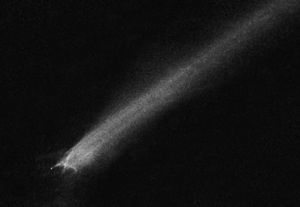
At
first astronomers though the object designated P/2010 A2 was a comet,
but this Hubble Space Telescope image, taken January 29, 2010, with the
Wide Field Camera 3, suggests that it wasn't behaving like a normal
comet.
Planetary scientists have known for decades
that there's no neat division between comets and asteroids. Some objects
look rocky and inert when discovered, only to develop big, obvious
gas-and-dust emissions later on (2060 Chiron comes to mind). Then again, occasionally a fuzzy, cometlike object ends up being a lifeless dud (such as "Comet" Wilson-Harrington).
Still, planetary astronomers acknowledge the existence of a handful of
legitimate comets in the asteroid belt, and initially it appeared that
the count had risen to five when the LINEAR survey spotted something
with a tail last January 6th. Within hours it earned the designation P/2010 A2, indicating its stature as a periodic comet.
But this one seemed odd from the get-go, particularly due to
its lack of a coma (cloud) surrounding its presumed nucleus and due to
an orbit wholly within the inner asteroid belt. Suspicions grew deeper
when David Jewitt (UCLA) and others wrangled some time on the Hubble
Space Telescope to get a better look. The Hubble image revealed a
bizarre X-shaped feature, strange striations in the dust tail, and (again) no hint of a coma.
The nucleus, only 24th magnitude in the Hubble view, corresponds to a
modestly reflective object about 400 feet (120 m) across. "It's
completely asteroidal," Jewitt told a gathering of planetary scientists
last week. Seeing Hubble's view, he realized it was "some kind of rock
that looks like a comet."
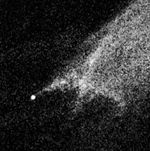
Enlarging
a Hubble Space Telescope image taken January 29, 2010, shows the
unusual crisscrossing filaments of the comet-like object designated
P/2010 A2. Note the how one strand extends to the "nucleus' at left.
But how - when - and why?
With the release today of a new series of Hubble images (choreographed
by Jewitt's team) and an additional view from the European Space
Agency's Rosetta spacecraft, it's now clear that P/2010 A2 resulted from
an asteroid's abrupt breakup in early 2009 - a full year before
astronomers picked up the pieces.
The eight Hubble images, taken this year between January 25th and May
9th, reveal a straight dust tail that gradually dimmed as the object
drifted farther from Earth. It's crisscrossed with streaks that appeared
to have be arcs of dust shed by the mysterious X and pushed outward by
solar radiation pressure. According to team member Jessica Agarwal
(European Space Agency), the 100,000 tons of ejected dust is mostly
millimeters to centimeters in size - far coarser than the usual
cometary fluff. No one can yet explain how the X-shaped feature came
about.
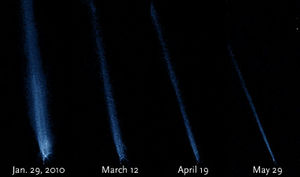
Four
Hubble Space Telescope images, taken over a five-month period, show the
odd-shaped debris that likely came from a collision between two
asteroids and created "comet" P/2010 A2.
Working
backward to get this Humpty Dumpty back together, Jewitt and his team
calculate that this could have been the result of that 400-foot asteroid
with a much smaller renegade rock about 15 feet (5 m) across. Jewitt
also cautioned his audience, "There is no proof that this was caused by
an impact." However, his Plan B would be equally bizarre: the asteroid
could have spun up so quickly (due to its interactions with sunlight) that it literally tore itself apart.
But the smart money is backing an outright collision. At the same
meeting, Colin Snodgrass (Max-Planck-Institute for Solar System
Research) and others deconstructed images of P/2010 A2 taken by the
ESA's Rosetta spacecraft on March 16th. En route to its flyby of the
large asteroid 21 Lutetia, Rosetta was positioned 10° above the object's
orbit plane.
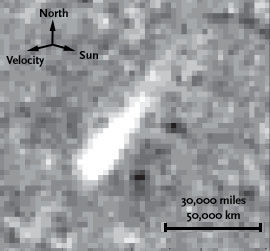
Rosetta's
snapshot of P/2010 A2, taken March 16, 2010, clearly shows that the
tail of dusty particles is neither aligned opposite the projected
direction of the comet's motion nor in the direction opposite the Sun.
iReport - This is video Captured with a low light "MeteorCam" of a fireball...
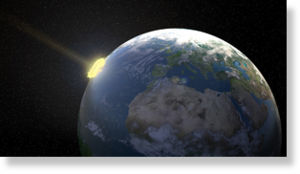


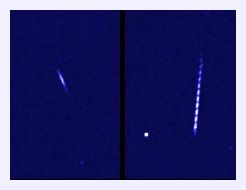
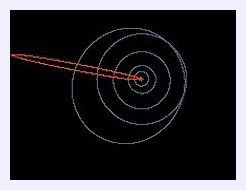



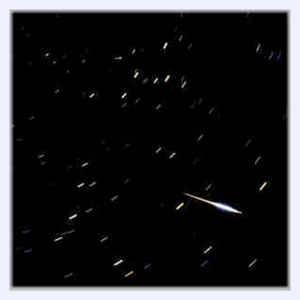
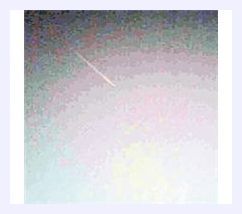
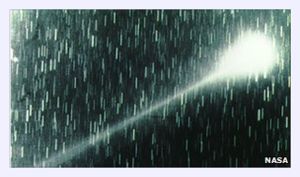

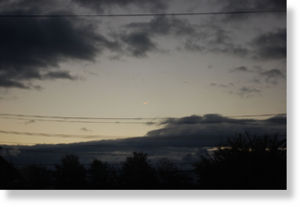

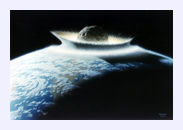
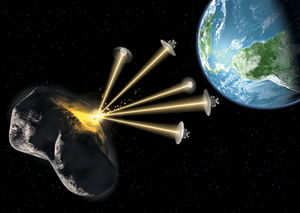

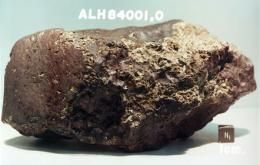
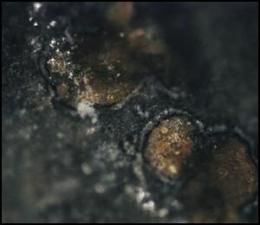
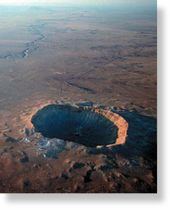
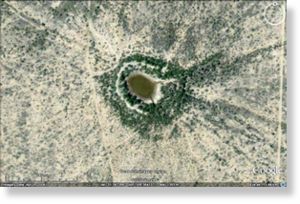
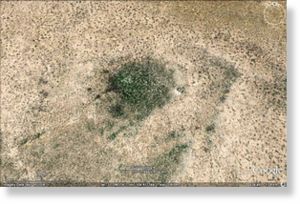
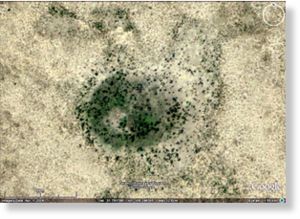
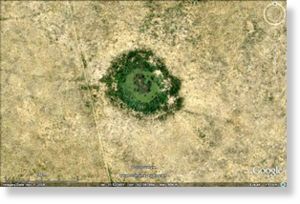
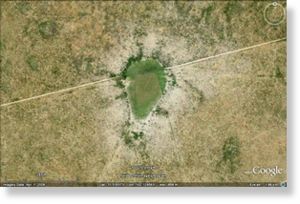
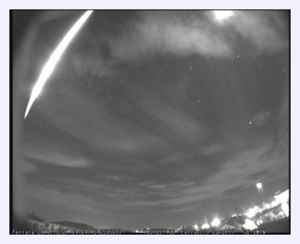
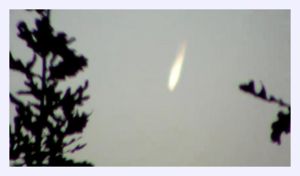
No comments:
Post a Comment